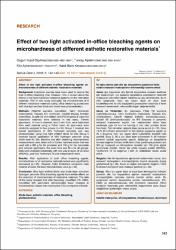| dc.contributor.author | Özyılmaz, Özgün Yusuf | |
| dc.contributor.author | Alptekin, Tuncay | |
| dc.contributor.author | Aykent, Filiz | |
| dc.contributor.author | Kara, Haluk Barış | |
| dc.date.accessioned | 2021-01-20T10:01:40Z | |
| dc.date.available | 2021-01-20T10:01:40Z | |
| dc.date.issued | 2018 | en_US |
| dc.identifier.citation | Özyılmaz, Ö. Y., Alptekin, T., Aykent, F. ve Kara, H. B. (2018). Effect of two light activated in-office bleaching agents on microhardness of different esthetic restorative materials. Selcuk Dental Journal, 5(2), 142-149. https://doi.org/10.15311/selcukdentj.344313 | en_US |
| dc.identifier.issn | 2148-7529 | |
| dc.identifier.uri | https://doi.org/10.15311/selcukdentj.344313 | |
| dc.identifier.uri | https://hdl.handle.net/20.500.12511/6314 | |
| dc.description.abstract | Background: Irradiation sources have been used to reduce the total in-office bleaching time. However, little is known about the effects of the light irradiation bleaching systems on the restorative materials. This in vitro study evaluated the microhardness of 6 different restorative materials during office bleaching procedures with blue light emitted diode and diode laser photoactivation. Methods: FiltekTM supreme (nanofilled), Tetric EvoCeram (nanohybrid), Tescera ATL (ormocer), Clearfill Majesty Esthetic (nanofilled), Durafill VS (microfilled) and IPS Empress II (ceramic) restorative materials were selected in this study. Twenty specimens, 10 mm in diameter and 2 mm thick, were fabricated from each material using a Teflon mold. All specimens were randomly assigned to two groups (n=10). Group 1 received two topical applications of 35% hydrogen peroxide and was photoactivated using blue light emitted diode for 20s. Group 2 received topical application of 46% hydrogen peroxide using diode laser for 30s. Baseline and after bleaching microhardness measurements were taken with a Vickers hardness tester that was used with a 300 g for the porcelain and 100 g for the composite and ormocer specimens, the dwell time was 30 s for all groups. Data were analyzed statistically, with one-way-analysis of variance (ANOVA), post-hoc Tamhane's T2 and independent t tests. Results: After application of both office bleaching agents, microhardness of all restorative materials tested were significantly decreased (p<.05). However, Tetric EvoCeram composite resin material showed the least microhardness value (p<.05). Conclusion: Blue light emitted diode and diode laser activation hydrogen peroxide office bleaching agents have similar effects on the reduction of microhardness of restorative materials. The data of this study revealed that after bleaching, nanofilled (FS, CME), microfilled (Df) specimens demonstrated lower changes in microhardness values than nanohybrid (TEC) composite material. | en_US |
| dc.description.abstract | Amaç: Işın kaynakları ofis tipinde beyazlatma süresini azaltmak için kullanılmıştır. Işık ışınlama beyazlatma sistemlerinin restoratif materyaller üzerindeki etkileri hakkında az şey bilinmektedir. Bu in vitro çalışmada, mavi ışık yayan diyot ve diyot lazer fotoaktifleştirme ile ofis beyazlatma prosedürleri sırasında 6 farklı restoratif malzemenin mikrosertlik değeri değerlendirildi. Gereç ve Yöntemler: Bu çalışmada, Filtek TM supreme (nanodolduruculu), Tetric EvoCeram (nanohibrit), Tescera ATL (hibritpolimer), Clearfill Majesty Esthetic (nanodolduruculu), Durafill VS (mikrodolduruculu) ve IPS Empress II (seramik) restoratif malzemeler seçildi. Her malzemeden teflon kalıp yardımıyla çapı 10 mm ve kalınlığı 2 mm olan yirmişer örnek hazırlandı. Tüm örnekler rastgele ikişer gruba ayrıldı (n=10). Grup 1'e,% 35 hidrojen peroksitten iki kez topikal uygulama yapıldı ve 20 s boyunca mavi ışık yayan diyot kullanılarak fotoaktif hale getirildi. Grup 2, 30 s için diyot lazer kullanılarak % 46 hidrojen peroksit topikal uygulaması yapıldı. Başlangıç ve beyazlatma sonrası değerler Vickers sertlik testi cihazı yardımıyla porselen için 300 gr; kompozit ve hibritpolimer örnekler için 100 gr’lık ağırlık kullanılarak ölçüldü. Veriler tek yönlü varyans analizi (ANOVA), Tamhane’s T2 ve bağımsız t testi ile istatistiksel olarak analiz edildi. Bulgular: Her iki beyazlatma ajanlarının kullanımdan sonra, tüm restoratif materyallerin mikrosertliğinde önemli derecede düşüş gözlemlendi (p<.05). Fakat en düşük mikrosertlik değerini Tetric EvoCeram kompozit rezin materyal gösterdi (p<.05). Sonuç: Mavi ışık yayan diyot ve diyot lazer aktivasyonlu hidrojen peroksit ofis tipi beyazlatma ajanları restoratif materyallerin mikrosertliğinin azalması üzerine benzer etkiler vardı. Bu çalışmanın verileri; beyazlatma sonrası nanodolduruculu (FS, CME) ve mikrodolduruculu (Df) örneklerin nanohibrit (TEC) kompozit materyale göre mikrosertlik değerlerinde daha düşük değişiklikler gösterdiğini ortaya çıkardı. | en_US |
| dc.language.iso | eng | en_US |
| dc.publisher | Selcuk University | en_US |
| dc.rights | info:eu-repo/semantics/openAccess | en_US |
| dc.subject | Diode Laser | en_US |
| dc.subject | Esthetic Materials | en_US |
| dc.subject | Office Bleaching | en_US |
| dc.subject | Photoactivation | en_US |
| dc.subject | Estetik Materyaller | en_US |
| dc.subject | Ofis Beyazlatma | en_US |
| dc.subject | Fotoaktivasyon | en_US |
| dc.subject | Diyot Lazer | en_US |
| dc.title | Effect of two light activated in-office bleaching agents on microhardness of different esthetic restorative materials | en_US |
| dc.title.alternative | İki ışıkla aktive olan ofis tipi beyazlatma ajanlarının farklı estetik restoratif materyallerin mikrosertliği üzerine etkisi | en_US |
| dc.type | article | en_US |
| dc.relation.ispartof | Selcuk Dental Journal | en_US |
| dc.department | İstanbul Medipol Üniversitesi, Diş Hekimliği Fakültesi, Protetik Diş Tedavisi Ana Bilim Dalı | en_US |
| dc.authorid | 0000-0002-9292-2074 | en_US |
| dc.identifier.volume | 5 | en_US |
| dc.identifier.issue | 2 | en_US |
| dc.identifier.startpage | 142 | en_US |
| dc.identifier.endpage | 149 | en_US |
| dc.relation.publicationcategory | Makale - Ulusal Hakemli Dergi - Kurum Öğretim Elemanı | en_US |
| dc.identifier.doi | 10.15311/selcukdentj.344313 | en_US |


















